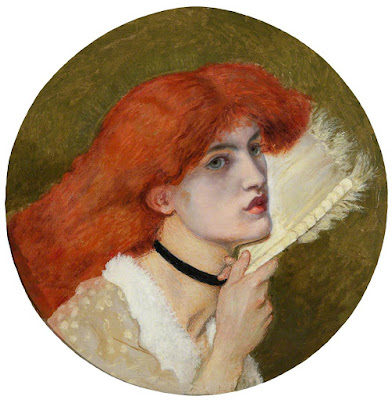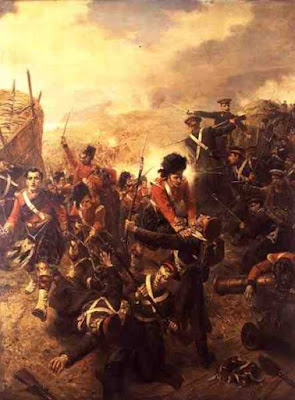Today marks the anniversary of Fanny Cornforth's death in 1909, at Graylingwell Asylum in West Sussex. I was trying to think of some aspect of Fanny's life that I haven't already gone on about, but I thought I'd go for the bigger picture. This is a post about why Fanny Cornforth is a lesson for all historians, especially those who write biographies...
 |
| Fair Rosamund (1861) Dante Gabriel Rossetti |
When I started researching Fanny Cornforth, back when dinosaurs ruled the earth, I did it because I wanted to know why someone who was seemingly loathed by so many people was so beloved by Rossetti. Not only that, but in most of the books I read in pursuit of her, I was continuously told that she had no real value. The quote I use the most is from Paull F. Baum's book of Rossetti's letters to Fanny (notice how there is only one letter from her, thus underlining her passive role in the story), that Fanny had no meaning other than in the narrative of Rossetti and his life. It is unsurprising that Baum, writing in the 1940s would take this view as it is entirely the view he was meant to have. Even within both Rossetti and Fanny's life time, people such as William Michael Rossetti, Ford Madox Brown and William Bell Scott were trying to shake off the tenacious Fanny. During DGR's breakdown of the early 1870s, the three men corresponded over how to pay her off, how to 'clear off all Fanny claims' (quoted in both W E Fredeman's article on Rossetti of 1971 and the essential Pre-Raphaelite Sisterhood by Jan Marsh). Fanny was not meant to be part of Rossetti's life after her role of model ceased with The Blue Bower, so her continuance in his life beyond that point was something to be erased...
 |
| The Blue Bower (1865) |
Had Fanny actually ceased to matter in 1865 then Stunner: The Fall and Rise of Fanny Cornforth would have been a much shorter book, but it wasn't just me that dragged Fanny on longer than William Michael wanted her to exist. His brother was partly to blame too...
 |
| Fanny Cornforth (1868) |
The trouble starts in 1868, when Rossetti produced this pastel portrait of Fanny. Seeing as she had dropped off his model 'lazy susan' in 1865, after he scrubbed her out of Lady Lilith (and arguably both Venus Verticordia and Monna Vanna too), her sudden reappearance in art three years later causes biographers some troubles. The canonical narrative given for Rossetti's art is this woman...
 |
| Elizabeth Siddal (1854) |
 |
| Fanny Cornforth (sketch for Fair Rosamund) (1861) |
...with a little bit of her...
 |
| Alexa Wilding (Sketch for Regina Cordium) (1866) |
 |
| La Donna Della Finestra (Jane Morris) (1879) |
If you will cast your minds back to this post from this time last year, then I covered how biographers within Fanny's life treated her. Spoiler alert: not well, on the whole. Whilst reading those biographies, it was evident that the writers felt conflicted over Alexa Wilding - how can she inhabit so many of Rossetti's visions during 'the Reign of Jane', which is agreed to have lasted from around 1868 to the end of his life. Poor old Alexa is quite easy to jettison from the narrative because firstly, as far as we know, and ignoring what I suggested for A Curl of Copper and Pearl, Alexa did not play a big part in Rossetti's personal life. Also, she kind of looks like Jane, apparently, and so I have seen great swathes of Rossetti's paintings on the internet where you'd think he only had the one model, who I like to call 'Fanjalezzi'. Damn, that girl is in everything...
 |
| Seriously Rossetti, when you pull this sort of thing, you only have yourself to blame... Jane with red hair in Mrs William Morris (1870) |
So, Rossetti had a moment of madness where he resurrected his past muse in that 1868 pastel. Well, how do we explain that? Well, he was beginning to lose his eyesight and some of his marbles so maybe he was under the illusion that Fanny was young and pretty again. After all, as stated in the 200 catalogue for The Blue Bower: Rossetti in the 1860s - 'This pretty vignette gives his rather stodgy housekeeper, now in her mid-thirties, something of the mysterious allure of a gypsy.' Mid-thirties? Heavens, it's a miracle she was allowed out without a bag on her head. So we can write it off as an aberration, a moment of madness. After all she was 'stodgy' by this point and no-one wants to see that. Plus he was far too busy digging up his wife and having it away with other people's wives to be bothering with Fanny.
Well, that's okay then. Glad he didn't complicate matters by doing it again...
 |
| Woman with a Fan (1870) |
Oh for goodness sake. Right, so why did he return to Fanny in 1870? Mentioned in both Marillier and Fred Stephens' early biographies of Rossetti, this is not seen as a problem. He just drew a pretty girl, which he was good at. Fred Stephens makes some remark about the hands being too big. You can understand the problems that trying to reintroduce Fanny into Rossetti's narrative caused. Within the narrative, Rossetti started his love affair with Jane Morris as early as 1865, but certainly could be raised to the status of 'obsession' (according to a recent exhibition) by the late 1860s, and in 1870 Rossetti painted her as Donna Della Finestra and La Donna Della Fiamma. There was no need for Fanny to raise her head so the picture is often written off as a flattery piece, a pay off for Fanny to sell. It's not meant to say anything about the artist's on-going relationship with the model, so that aspect of it is often brushed over and we move on the endless swathes of Jane that filled the last dozen years of his life. Yes, Alexa was there but just to vary it up a bit. He loved Jane and so therefore no other face would do.
 |
| Fanny Cornforth (1874) |
Oh, now, you are doing it on purpose Rossetti! Fresh from all manner of romantic shenanigans at Kelmscott, Rossetti produced this pastel of a seemingly nude (or topless) Fanny Cornforth, in her late 30s. The general dismissal of this picture as being, again, a flattery piece, is more of a reflection on the commentator who do not believe that a woman in her 30s should be seen as attractive, apparently. There is an odd mixture of comments about how Fanny could not possibly have looked like this in 1874 because doesn't everyone say she was fat? Also, Rossetti's in love with Jane therefore can't also fancy a bit of old Fanny on the side.
 |
| Fanny Cornforth (1874) |
Strangely, commentators feel they are on firmer ground with the image of Fanny clothed from 1874 because then words like 'matronly' (again, thank you to The Blue Bower catalogue) can be used. Again, it is the consensus of the critics that the image is not sexy therefore Rossetti cannot have intended it as sexy. Oddly, we never have this conversation about the myriad images of Jane which are arguably overtly threatening (such as Astarte Syriaca). No matter how complicated Rossetti's images of Jane become, we never question his desire for her, but somehow it is beyond our ken to imagine he fancied a woman of 39.
 |
| Fanny Cornforth (1874) |
Damn it, Rossetti, stop drawing Fanny Cornforth! The third pastel definitely brings matters to a head because to draw one's ex-mistress once is a mistake, to do it twice is unfortunate, but three times makes it look like you are doing it on purpose. The theory that he made these pastels to give Fanny something she could sell is slightly undermined by the fact that she hung onto them until Fairfax Murray sold them through to Birmingham Art Gallery when she finally had to start selling off her collections in order to eat. Not only that, we're not even sure that she owned the last one at all. Despite the lack of information, biographers feel comfortable in assigning emotions, desires, motivations and general thought-processes to five works of art that span 6 years. By 1874, Fanny was financially independent of Rossetti to a level she hadn't achieved in the rest of their relationship. Timothy Hughes had died and she had taken up with Mr Schott, running the Rose Inn and attempting to remain secure after Rossetti dumped her then attempted to reinstate her. there are powerful arguments for how these pictures are gifts of love between two people who have been through quite a lot together, rather than little more than a gift voucher. As much as Fanny ever relied on Rossetti for money, he completely relied on her for his drugs, his paint, and levels of understanding that his friends and family found it difficult to give.
But then that doesn't fit in the narrative. Therein lies the moral of today's post.
It's okay to disrupt the narrative. It's okay to think people are more complex than we would like them to be. I have no clue about how all Rossetti's women fit together (if you excuse the phrase) but then I suspect he didn't either. It's not that we want an easy story, but possibly sometimes the sheer messed-up complexity of people make telling any sort of accurate narrative impossible, therefore as biographers we have to chose a path. In many ways life is easy for me because when I started writing about Fanny (and about Mary Hillier) the narrative path placed down for them was entirely dependent on another person and so I can easily stray, meander, offer alternatives and generally disrupt the narrative because I am giving you a whole person rather than the shadow that is required for someone else's story. With people like Rossetti, it is patently impossible to pick apart the truth because we have endless accounts of what he said and what he did and people's interpretation of all that, not to mention his art, and none of it follows a single, simple path. Don't try and force a narrative where there might not be one, and embrace the terrible mess people's lives get into.
After all, it's what made me interested in Fanny Cornforth in the first place.





































